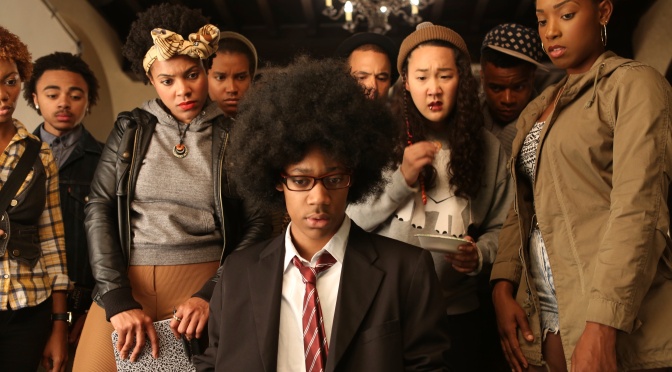David L. Garcia
Staff Writer
“Dear White People” tackles big questions about race and identity with the bluntness of a sledgehammer, but never falls victim to preachiness or sensationalism. Like the best satire, it uses humor to effortlessly force you to question yourself and the world around you. Director and writer Justin Simien’s debut is a brilliant film. Its mixture of sympathy and anger lets him ask big questions, even while admitting that neither he, nor anyone else, really has the answers.
The film takes place at the prestigious, pompous, and primarily white Winchester University. We are told a race riot broke out at the university, following a Halloween party with an “unleash your inner Negro” theme. We are then shown the days leading up to the party, and learn how racial tensions escalated upon the election of Sam White as head of a primarily black residence hall. Here, she tries her hardest to “bring black back to Winchester.” Sam’s brash attitude captures the attention of the campus humor magazine, who use her movement as inspiration for their party.
The film introduces us to several black students, all trying to find a balance between the expectations set out for them and their personal identity. Sam uses her searing radio show, “Dear White People,” to hide the fact that she’s half white. Colandrea Conners, a reality TV wannabe, does everything possible to assimilate, wearing blue contact lenses and going by the name Coco. Troy Fairbanks, the handsome and preppy son of the school’s dean, tries his best to live up to his father’s lofty expectations, and has to practice his dream of writing comedy in secret.
Finally, there’s Lionel Higgins, easily the film’s most sympathetic character. His skin color and huge Afro keep him from being truly accepted by white students, while his love of Mumford and Sons and “Star Trek” distances him from his fellow black students. Some of the most overt racism in the film comes from Lionel’s editors on the school paper, who recruit him solely to write about black culture, despite the fact that he doesn’t fit into that mold.
Director Justin Simien purposefully placed the characters in these difficult situations, and uses the film’s stirring climax to finally give them the identity they’ve been searching for. “All of the characters make choices at the end that…on the surface, you might say ‘whoa, that’s not cool,” said Simien in an interview with the Foghorn, “but knowing who they are, and knowing the nuances of their lives, it’s the only authentic choice they could’ve made.”
Simien, a Houston native, based much of the story on real-life experiences. “Everything in the film is sort of anecdotal. There’s definitely a lot of me in there. When you’re constantly up against what people expect of you, because of your race, it makes it very difficult to make decisions that you really want to make. It’s very difficult to be true to yourself.”
Sound heavy? Don’t worry. The humor is constant, and it’s as sharp as a scalpel. The quotes from Sam’s radio show are wickedly spot on–“Ever spend a second deciding whether to use black or African-American? Yeah, that’s racist”–and Simien’s interpretations of race in popular culture are all the more hilarious because they might as well be true. You’ll never watch the film “Gremlins” the same way again, not after Simien points out that the gremlins “are addicted to fried chicken and freak out when you get their hair wet.”
Simien wrote the first drafts of the film as a student at Chapman University, and always knew that humor was necessary for a film like this. “A comedy makes you think. When you laugh at something, it’s a process in your brain. You’re thinking about something,” he said. “I think that with a comedy you’re able to talk about ideas, at just enough distance to where you can engage with them, think about them. It was always the only option in my head.”

